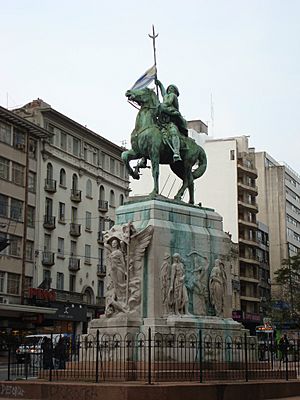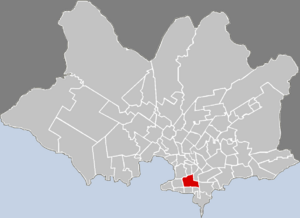Cordón facts for kids
Quick facts for kids
Cordón
|
|
|---|---|
|
Barrio
|
|

The El Gaucho monument, a national symbol, at the West entrance of Cordón, on 18 de Julio Av.
|
|

Street map of Cordón
|
|

Location of Cordón in Montevideo
|
|
| Country | |
| Department | Montevideo Department |
| City | Montevideo |
Cordón is a busy barrio (which means neighborhood or district) in Montevideo, Uruguay. It's located just east of the city's main downtown area, called the Centro. The most important street running through Cordón is 18 de Julio Avenue.
Contents
History of Cordón
Cordón was the very first neighborhood built outside the old walls of Montevideo's original city center, known as the Citadel. Long ago, people called this area "El Cardal." This name came from the thistles (called Cardos in Spanish) that grew in the fields where corn was planted. It was a big open space beyond the city's defenses.
How Cordón Got Its Name
In 1765, the Spanish rulers decided to plan out about 60 city blocks for people to live in. The area to the east of this new plan was named "Cordón." This name came from the Spanish word for "laces" (Cordones). This is because the workers used long ropes or laces to mark out the land for the new streets and buildings.
Early Events
In January 1807, the entire Cordón area became a battlefield. This was during the second British invasion of the River Plate region. This event is known as the Battle of Cardal. Later, in 1892, an old English Cemetery in the area was replaced by a parade ground. In the 1950s, this parade ground became the Montevideo City Hall, which is where the city's government works today.
Where is Cordón?
Cordón is located east of the Centro neighborhood. This means it's part of Montevideo's main business area. To the northeast, you'll find Tres Cruces. To the east is Pocitos. If you go north, you'll reach Aguada and Villa Muñoz. To the south are Palermo and Parque Rodó.
Cool Places to See
Cordón is home to many interesting places and important buildings.
Plaza de los Treinta y Tres
On 18 de Julio Avenue, you'll find the Plaza de los Treinta y Tres. People often call it Plaza de los Bomberos because the main Fire Department building is right across from it. In the square, there's a monument dedicated to the Thirty-Three Orientals. This monument is a copy of a famous painting by Uruguayan artist Juan Manuel Blanes, made with painted ceramic tiles. You can also see a bronze statue of Juan Antonio Lavalleja on a horse. There's even a statue of a firefighter holding a baby, and a bronze statue of Albert Einstein chatting with Uruguayan philosopher Carlos Vaz Ferreira, both sitting on a bench!
Important Buildings
Cordón has many buildings that are important for their architecture and what they do. These include:
- The National Library, where tons of books and important documents are kept.
- The University of the Republic, a big university where many students go to learn.
- The Alfredo Vásquez Acevedo Institute, another important educational building.
- The main office of the Banco de Previsión Social, which is a big social security bank.
Feria de Tristán Narvaja
One of the most famous spots is the Feria de Tristán Narvaja. This is a huge street market that happens every Sunday! It started way back in 1909 and has become a popular place for both locals and tourists to visit. You can find all sorts of things there, from antiques to fresh produce.
Cordón Soho
Since the mid-2010s, a part of Cordón has become very trendy. This area, especially around Bulevar España, is now called Cordón Soho. It's named after the famous SoHo neighborhood in New York. Here, you'll find lots of cool places like:
- Breweries
- Bars
- Unique restaurants
- Cafes
- Nightclubs
- Fashionable clothing stores
- Design shops
It's a great place to hang out and explore!
Schools in Cordón
Cordón has several schools where students can learn:
- Colegio y Liceo Sagrado Corazón, also known as "Seminario." This is a private school run by the Society of Jesus, which is a Roman Catholic group.
- Colegio Nacional José Pedro Varela, a private school that is not connected to a specific religion.
- John XXIII Institute, another private school run by the Salesians of Don Bosco, a Roman Catholic order.
Places to Worship
There are some important churches in this neighborhood:
- Our Lady of Mt. Carmel, often called "Iglesia del Cordón." This is a Roman Catholic church.
- Church of the Sacred Heart, also known as "El Seminario." This is a Roman Catholic church run by the Jesuits.
- Church of Our Lady of the Rosary and St. Dominic, also known as "Los Domínicos." This is a Roman Catholic church run by the Dominicans.
See also
 In Spanish: Barrio Cordón para niños
In Spanish: Barrio Cordón para niños
- Barrios of Montevideo

